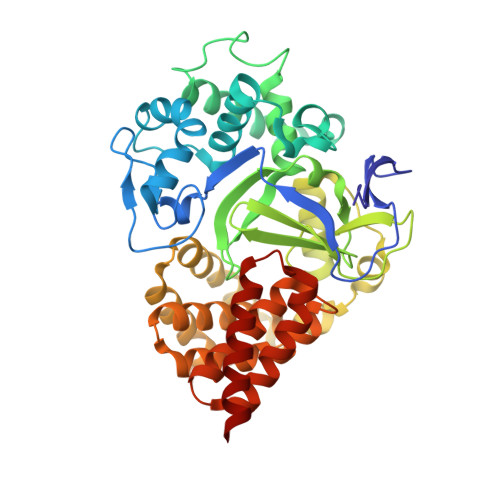Discovery of the SMYD3 Inhibitor BAY-6035 Using Thermal Shift Assay (TSA)-Based High-Throughput Screening.
Gradl, S., Steuber, H., Weiske, J., Szewczyk, M.M., Schmees, N., Siegel, S., Stoeckigt, D., Christ, C.D., Li, F., Organ, S., Abbey, M., Kennedy, S., Chau, I., Trush, V., Barsyte-Lovejoy, D., Brown, P.J., Vedadi, M., Arrowsmith, C., Husemann, M., Badock, V., Bauser, M., Haegebarth, A., Hartung, I.V., Stresemann, C.(2021) SLAS Discov 26: 947-960
- PubMed: 34154424
- DOI: https://doi.org/10.1177/24725552211019409
- Primary Citation of Related Structures:
7O2A, 7O2B, 7O2C - PubMed Abstract:
SMYD3 (SET and MYND domain-containing protein 3) is a protein lysine methyltransferase that was initially described as an H3K4 methyltransferase involved in transcriptional regulation. SMYD3 has been reported to methylate and regulate several nonhistone proteins relevant to cancer, including mitogen-activated protein kinase kinase kinase 2 (MAP3K2), vascular endothelial growth factor receptor 1 (VEGFR1), and the human epidermal growth factor receptor 2 (HER2). In addition, overexpression of SMYD3 has been linked to poor prognosis in certain cancers, suggesting SMYD3 as a potential oncogene and attractive cancer drug target. Here we report the discovery of a novel SMYD3 inhibitor. We performed a thermal shift assay (TSA)-based high-throughput screening (HTS) with 410,000 compounds and identified a novel benzodiazepine-based SMYD3 inhibitor series. Crystal structures revealed that this series binds to the substrate binding site and occupies the hydrophobic lysine binding pocket via an unprecedented hydrogen bonding pattern. Biochemical assays showed substrate competitive behavior. Following optimization and extensive biophysical validation with surface plasmon resonance (SPR) analysis and isothermal titration calorimetry (ITC), we identified BAY-6035, which shows nanomolar potency and selectivity against kinases and other PKMTs. Furthermore, BAY-6035 specifically inhibits methylation of MAP3K2 by SMYD3 in a cellular mechanistic assay with an IC 50 <100 nM. Moreover, we describe a congeneric negative control to BAY-6035. In summary, BAY-6035 is a novel selective and potent SMYD3 inhibitor probe that will foster the exploration of the biological role of SMYD3 in diseased and nondiseased tissues.
Organizational Affiliation:
Bayer AG, Global Drug Discovery, Berlin, Germany.

















